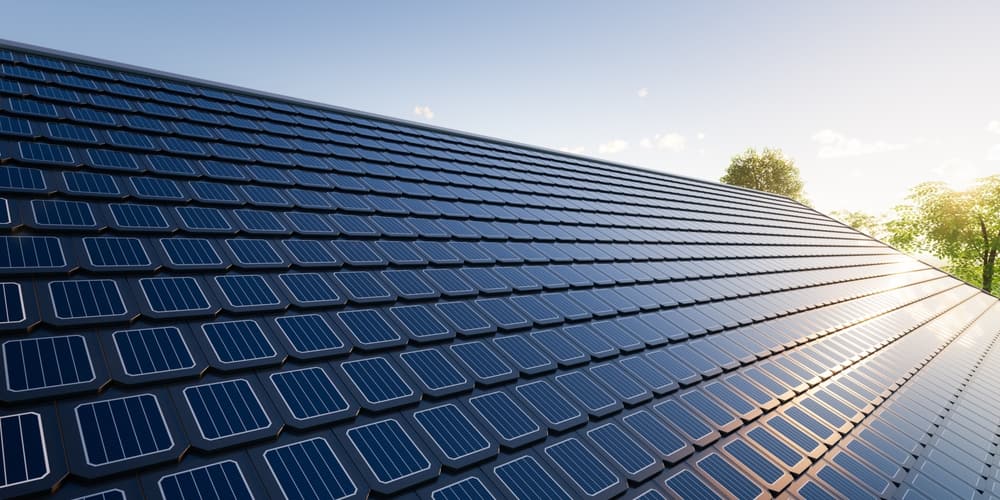Are you considering a home improvement project that combines aesthetic appeal with environmental responsibility? Look no further than Pinnacle Home Improvements. As a trusted leader in the industry, Pinnacle Home Improvements specializes in providing top-notch solutions for your roofing needs. This is why we are well known in the area as a top roofing company.
In this blog post, we will explore the benefits of solar roof tiles and how Pinnacle Home Improvements can help you harness the power of the sun to transform your home into an energy-efficient oasis.
Everything You Need to Know About Solar Roof Tiles: Unveiling the Future of Home Energy
Solar roof tiles, also known as photovoltaic shingles, combine the benefits of solar power with the aesthetic appeal of traditional roofing materials. As an innovative approach to harnessing sunlight to generate electricity, these tiles offer homeowners a sustainable and cost-effective power solution. They function by incorporating thin photovoltaic cells that convert sunlight into electricity, which is then used to power a home. The seamless integration into the roof allows for a sleek design that maintains the home’s traditional appearance while providing an eco-friendly energy source.
One of the primary advantages of solar roof tiles is their dual functionality. Not only do they protect the dwelling from the elements, as any good roofing material should but they also generate electricity, reducing dependence on grid-supplied power and potentially lowering energy bills. The installation of solar roof tiles can increase a property’s value by improving its energy efficiency and reducing its carbon footprint.
In terms of operation, solar roof tiles are designed with efficiency in mind. Each tile is equipped with a photovoltaic cell that captures sunlight and transforms it into direct current (DC) electricity. An inverter then converts this DC electricity into alternating current (AC), which can be utilized for household needs or fed back into the grid. The integration of these tiles into existing roofing structures has become increasingly streamlined, enabling more homeowners to take advantage of this renewable energy technology without compromising on style or structural integrity.
Benefits and Advantages
Solar roof tiles offer a unique combination of economic and environmental advantages, with distinct benefits over traditional roofing materials. They represent a fusion of traditional aesthetics with modern solar technology.
Economic Benefits
Solar roof tiles provide significant long-term savings on electricity bills. Over their lifespan, they generate a return on investment through the production of renewable energy. The initial costs are mitigated by:
- Lower energy bills: Homeowners can reduce their reliance on the grid as solar roof tiles harness free and abundant solar energy.
- Government incentives: In many regions, tax credits, rebates, and other incentives are available for solar energy installations.
Environmental Impact
The adoption of solar roof tiles contributes positively to environmental conservation efforts. Their impact includes:
- Reduction in greenhouse gasses: By generating clean electricity, solar roof tiles cut down on carbon emissions typically associated with conventional power sources.
- Sustainable production: They are often made using sustainable practices and materials, which further lessens environmental footprints.
The Advantage of Solar Roofing Solutions Over Traditional Materials
Solar roof tiles offer resilience and aesthetic harmony, alongside their energy-generating capability, compared to traditional materials. Their advantages are:
- Integrated design: Unlike bulky traditional panels, solar roof tiles blend seamlessly with conventional roofing materials, preserving the home’s aesthetic.
- Durability: They are designed to withstand harsh weather conditions, which can even surpass the resilience of many conventional roofing materials.
Costs and Savings of Solar Roofing Tiles
Investing in solar roof tiles is a significant financial decision. Homeowners should understand both the initial costs and the potential savings to make an informed choice.
Long-Term Savings
The major draw of solar roof tiles is their ability to generate savings over time. Homeowners typically see a reduction in their electricity bills, as solar tiles harness the sun’s power to produce energy. They can expect savings on utility bills that increase as electricity prices rise. Furthermore, solar roof tiles contribute to increasing a property’s value, often leading to higher resale prices.
Cost-Benefit Analysis
A thorough cost-benefit analysis often demonstrates that the initial investment in solar roof tiles is offset by the long-term financial benefits. These tiles come with a higher upfront cost compared to traditional roofing materials; however, tax incentives, rebates, and solar renewable energy credits (SRECs) can significantly reduce the effective cost. It’s essential to assess factors such as the size of the roof, energy consumption, local solar incentives, and the efficiency of the solar tiles. These variables affect how quickly homeowners can recoup their investment and start saving.
Selection and Installation of Solar Roofing Systems
Selecting the right solar roof tiles and understanding the installation process are critical steps towards integrating sustainable energy solutions into one’s home. These decisions influence the efficiency, aesthetics, and overall satisfaction with the solar roofing system.
Choosing the Right Tiles
When selecting solar roof tiles, homeowners should evaluate several factors to ensure they make informed decisions.
Key factors to consider include:
- Efficiency: The power output, typically measured in watts, indicates the efficiency of the solar tiles. Higher ratings generally yield greater electricity generation.
- Durability: High-quality tiles are essential for withstanding environmental factors such as hail, wind, and UV exposure.
- Warranty: Look for long-term warranties that cover tile performance and weather resistance.
- Aesthetics: Solar tiles come in various styles to complement a home’s architecture.
- Certifications: Ensure the solar tiles meet relevant industry standards and certifications for safety and performance.
Local climate and roof angle should also be factored into the decision to optimize solar absorption.
Types of Solar Roof Tiles:
- Monocrystalline and polycrystalline options for different efficiency and cost needs.
- Thin-film solar tiles are lightweight and flexible, suitable for roofs unable to support heavier tiles.
- Integrated photovoltaic systems blend seamlessly with traditional roofing materials.
Installation Guidelines
The installation of solar roof tiles requires meticulous planning and adherence to technical guidelines to ensure the system functions effectively.
Installation Steps:
- Site Assessment: Professional evaluation of the roof’s structure, orientation, and sun exposure.
- Permitting: Securing necessary building and electrical permits in accordance with local regulations.
- Sub-roof Preparation: Reinforcing the roof, as needed, and ensuring proper underlayment for the tiles.
- Tile Placement: Careful arrangement of solar tiles to maximize exposure and energy production.
- Wiring: Safe integration of electrical components, including inverters and power optimizers.
- Testing: A thorough check to confirm the system’s functionality prior to final approval.
Working with certified installers is strongly recommended to guarantee installation quality and adherence to safety standards. It is imperative to engage with professionals who are well-versed in local legislation and utility company policies regarding solar installations.
Maintenance and Misconceptions
Solar roof tiles require minimal maintenance, and many common beliefs about their upkeep and functionality are unfounded. This section addresses the actual maintenance needs of solar roof tiles and dispels prevalent myths that may deter homeowners from considering them.
Upkeep Requirements
Solar roof tiles are designed for durability and low maintenance. They typically require:
- Inspection: An annual check to ensure no tiles are damaged or obstructed.
- Cleaning: Occasional cleaning, mainly to remove debris, dust, or snow, which can be done with standard hose water.
However, specifics may vary by manufacturer, so owners should consult their user manuals for precise guidelines.
Dispelling Myths
- Fragility: Solar tiles are often believed to be fragile, but they are actually engineered to withstand harsh weather, such as hail and heavy rain.
- Aesthetic Concerns: Contrary to the belief that solar options are unsightly, solar tiles blend seamlessly with traditional roofing materials.
- Energy Production in Cloudy Weather: They can still generate electricity under cloudy conditions, albeit at reduced efficiency.
| Concern | Fact-Based Response |
| Longevity | Solar roof tiles have a lifespan comparable to traditional roof tiles, often around 30 years. |
| Installation | Professional installation ensures tiles are integrated correctly without harm to roof integrity. |
| Repairs | Damaged tiles can be individually replaced without the need to refurbish the entire roof. |
By understanding the actual requirements and dispelling misconceptions, homeowners can make informed decisions about solar roof tiles.
The Future of Solar Technology
Solar technology is continually advancing, and solar roof tiles are poised to play a pivotal role in the transformation of home improvements. One can anticipate significant enhancements in efficiency. Third-generation solar cells, such as perovskite, are expected to offer higher energy conversion rates.
The incorporation of Building-Integrated Photovoltaics (BIPV) is a key trend, merging energy generation with aesthetically pleasing designs. This integration allows homeowners to replace traditional roofing materials with solar roof tiles that blend seamlessly with their home’s architecture.
Moreover, the rise in smart home technology aligns with solar advancements. Future solar tiles may integrate with home energy management systems to optimize electricity usage. Homeowners will benefit from real-time data to maximize their energy savings.
Future Implications:
- Increased energy independence for homeowners
- Reduction in carbon footprint
- Enhanced property value
| Aspect | Current Status | Future Expectations |
| Efficiency | Up to 22% | Potential increase beyond 30% |
| Aesthetics | Variety of styles | Wider range, customizable options |
| Smart Integration | Limited | Full integration with smart homes |
| Cost | Price dropping, but initial cost is high | Further reduction in costs and break-even time |
As these technologies are refined, it is likely that the installation and maintenance of solar roof tiles will become simpler, further accelerating their adoption. The enhanced efficiency and harmonious design of future solar roof tiles will drastically augment the role of sustainable energy in home improvements, making them an even more attractive investment for eco-conscious homeowners.
For additional information on solar roof tiles, contact the team at Pinnacle Home Improvements.








